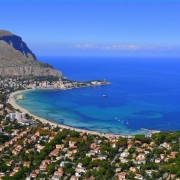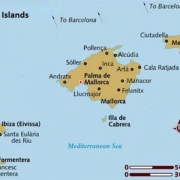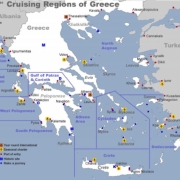Chartering a yacht in the Gulf of Naples
16 July 2016




If you are a vigorous traveller and yacht charter enthusiast, chartering a yacht in the Gulf of Naples is a privileged way to get to know this area, rich in history, culture, gastronomy and art. Visiting Naples and surrounding areas should be on top of your priorities while travelling on board one of our charter yachts in the Mediterranean destinations.
Naples or “Napoli” in Italian , is the capital of Italian region of Campania, situated on the south-west of the Italian peninsula, 230 km from Rome. Theories of the foundation of Naples are obscure; one of them holds it that the city was founded by Cumaeans in 6th century BC and called Neapolis – “new city”. The choice of location was certainly fortunate: with a wonderful climate, luxurian nature and an enchanting view of one of the most beautiful gulfs in the world, in Roman times Naples began to expand and prosper, inspite of long periods of foreign domination by Byzanthines, Goths, Normans, Swabians, Angevins, Aragons and Bourbons. Romulus, Augustulus, Tancred, Frederick II, Charles I of Anjou, Johanna I, Ferdinand I of Aragon, Philipp II of Habsburg, the viceroy Don Pedro of Toledo, and Joachim Murat: all of them held Naples and marked its history.
If you embark on board of one of our charter yachts in Naples, choose the Marina Sannazzaro Mergellina (also called Marina Molo Luise) situated at the foot of Posilippo hill in the very down-town of Naples, and in the center of the gulf of Naples. Marina Molo Luise is well appointed, suitable for yachts up to 70m in size and only 35 minutes drive from Napoli Capodichino International Airport. If you where to arrive Naples by lunch time: you should enjoy a meal in “Villa Donn’Anna Palaccio Petrucci”, a Michelin star restaurant, with splendid view over bay of Naples and modern decorum integrating a part of the ancient walls of antique Palaccio Petrucci.
Before you start chartering a yacht in the Gulf of Naples, spend some time walking down the ancient streets of Naples and breathe-in its unique atmosphere and inimitable way of life.
DISCOVER NAPLES
Naples is an art city in the true sense of the word, whose streets are shrewd with splendid and grandiose monuments. The commercial and municipal center of the city, Piazza Municipio, unites some of them: Castle Castel Nuovo (also called Maschio Angioino – The Angevin Keep), built by Charles de Anjou in 1297, famous for its frescoes, silver and bronze collections; Galleria Umberto I, 57.5 m high in vertex and full covered in glass; picturesque Piazza Trieste e Trento; Teatro San Carlo , second in Italy only to La Scala in Milan, constructed by the Sicilian architect Giovanni Antonio Medrano in 1737. Proceed from Piazza Treste e Trento along the wall of Palazzo Reale, until reaching Piazza del Plebiscito, grandiose square at the foot of mount Echia, that opens out to Pizzofalcone district, standing on remains of volcanic crater of Mount Ischia and known since Latin times.
The imposing Palazzo Reale and its 170-meter original facade, was built in 1600-1602 as residence for the viceroy Fernandez Ruiz de Castro and was used since by many of the Napoli rulers including the Bourbons. The Palazzo Reale houses the Biblioteca Nazionale di Napoli – the national library – containing important works including the Herculaneum papyruses. Right in front of the Palazzo Reale is the majestic Basilica of San Franseco di Paola, crowned by the grand semicircular arcade, supported by Doric columns.
Descending towards the sea by Via Cesare Console, one may see the small church of Santa Lucia a Mare of 9th Century. The promenade down on Via Nazario Sauro is very pleasant due to the spectacular views of the city and the open sea, ending with the Immacolatella Fountain or Fontana del Gigante, located on one of the most scenic areas of the city. At hand’s reach from here to Borgo Marinaro – one of the most characteristic areas of traditional Naples, still maintaining rhythms and customs difficult to find in other parts of the city, that you may want to visit while chartering a yacht in the Gulf of Naples. Castel Dell’Ovo – the massive fortress that stands on the peninsula of Borgo Marinaro. One of the symbols of Naples, Castel Dell’Ovo was built in 1128 on ruins of a monastery, and was used as prison by many famous rulers of Naples.
If you visit Naples for the first time, on board of a charter yacht, you may not resist to the city’s undisputable charm and richness and you may want to continue walking its streets gazing at splendid palazzos, villas, and of course, churches. That will give you a break, if your yacht charter came from westbound and you feel a need of solid ground under your feet.
So, continuing your visit of Naples, do not miss the opportunity to visit typical Neapolitan district of Spanish Quarters, situated nearby the Piazza Trieste e Trento on the street Via Toledo, named after the viceroy Pedro of Toledo, who ordered it’s construction in 1536 with the idea of creating a new noble settlement. The project was a great success, and around the elegant buildings, soon lower class neighborhoods grew as well. Densly populated, Spanish quarters perfectly represent the neapolitan “philosophy of life”, having preserved the original style from urbanization.
Some famous ancients palazzos and churches are located in this area: Santa Brigida church, from mid-17th century, with valuable paintings of Luca Giordano, such as Apotheosis of Saint Brigida, Sant’Anna dei Lombardi church (also known as the church of Monteoliveto), constructed back in 1411 and known for famous frescos of Giorgio Vasari and numerable sculptures of Renaissance epoch; Gésu Nuovo Church of 16th century with wonderful baroque interior.
Santa Chiara Church and Cloister, built in 1310-1328 in Provencal style, was nearly destroyed by bombing in 1943 and then restored to its original forms. The church is famous for its ornamentation in majolica tiles and tombs of Robert I of Anjou and Marie of Valois.
San Gregorio Armeno Cathedral was built by order of Charles II of Anjou in late 13th century, on the site of earlier cathedral of 5th century, and dedicated to St. Januarius, who, by legend, freed the city from plague in 1527. Commemorating this event, the chapel of Saint Januarius, and here on the back wall there are phials containing the dried blood of the Saint, which , twice a year, liquefy, repeating a miracle of ancient origin, that dates back to the reign of Emperor Constantine.
Among monuments of the pre-Christian era are the Greek walls, excavations near the Piazza Bellini of the ancient primitive settlement of Paleopolis (or Parthenope).
The famous San Gennaro Catacombs is the unique religious and burial site in the district of Rione Sanità on the slopes of Capodimonte hill. The site appeals to both pagan tradition of worshipping the dead and to early Christianity. The original nucleus of the catacombs was a noble’s family tomb from 2nd century AD; then, in 4th century the exposition was expanded by the entombment of the first Naples bishop, St. Agrippinius, with the contraction of a basilica that still contains the bishop’s chair, carved in tuff. Further expansion began in 5th century with moving here the remnants of San Gennaro, the Saint martyr and Naples’s protector who was beheaded in Pozzuioli in 3rd century. Built on three underground levels (with third-lowest level discovered recently), the Catacombs contain over 2000 mortuary dugs in form of arcosolium (built for rich people and ornamented with paintings and frescoes), aedicule (mortuary temple) and cubiculum (vaulted burial chamber, as the one built for San Gennaro remnants).
The National Archaeological Museum of Naples grew around collections of the Farnese family, bequeathed to Charles Bourbon by his mother Elisabetta Farnese. The museum has one of the largest and most important collections of classical antiquites in the world, including priceless sculptures, paintings, frescoes, jewelry from Pompeii and Herculaneum, as well as the Borgia collection of precious Egyptian objects.
When chartering a yacht in the Gulf of Naples, you will be astonished by the view of Mount Vesuvius, from on board of your charter yacht – and this is the only active volcano on continental Europe and the undisputed symbol of Naples. The beginning of Mt. Vesuvius’ historical activity, culminating in the catastrophic eruption on 24th of August in 79 AD that buried the cities of Pompeii and Herculaneum (Ercolano): the pressure of magma opened up an underground conduit and sped out with awesome violence in the form of boiling mud, lava, rocks, lapillus, poisonous gases and ashes, ripping apart the Vesuvius summit, giving the volcano the form we can witness today.
HERCULANEUM
Herculaneum (Ercolano), founded by Herculas as per mythological tradition, actually was of Greek origin, ruled by Greeks of Neapolis and Cumae. At the time of Vesuvius’ explosion, Herculaneum was engulfed by a huge river of mud and debris, and the inhabitants tempted to reach the sea shore (the city was situated on the coast line at those times) but they were held back by a violent tidal wave. One can witness even nowadays the brutality of the event by observing the human remains in the city gates, leading towards the sea. The solidified mud preserved the town till the time of its first excavations in 1709, by Austrian prince d’Elbeuf.
SORRENTO COAST
Heading southbound the bay of Naples, on board of a charter yacht, you will navigate along the splendid Sorrento coast. Another big city, Castellamare di Stabia, is half way between Naples and Sorrento. Castellamare has two well-appointed yachting marinas: Stabia Main Port and Marina di Stabia. Stabia Main Port, the new yachting marina, inaugurated only in 2015, has already become popular between the owners of superyachts and megayachts. Located right in the historic center of Castellamare di Stabia, the port provides security, technical assistance to crew, refueling, and above all, berths for 130 yachts including 25 for superyachts between 30 and 120 m. The RnB queen, Beyoncé, chose Stabia Main Port as the embarkation port for her charter in 2015.
If you plan to celebrate a memorable event while chartering a yacht in the Gulf of Naples, and if you are looking for an appropriate place to celebrate it and to surprise your guests, the ideal place will be the Castello Medievale. This medieval castle (from which Castellamare di Stabia got its name) was built in 9th century to guard the narrow stretches of the coast, between the impervious mountain and the sea, which was the only way an enemy could penetrate the land and gain access to the Sorrentino Peninsula. The construction was ordered by the Duke of Sorrento. The castle was transformed many times during its glorious history and acquired its modern aspect in 1470. In 1931 the Castle became a private property and a restaurant project began with the aim of saving outer walls and the existing structures. The owner herself, charming Valeria Della Rossa, will warmly greet you and will be your guide. This Castle is very well preserved and contains many original interior belongings, such as the Treasury safebox of the Municipality of Umbria, dated 500 AD, and one of the rarest antiquities: a tapestry named “Arriving of Vespasian to Coliseum”, from 500 AD, one of 7 most ancient existing tapestries, known as “7 wonders of the world”.
The Castello Medievale can be rented (except private apartments) for private events. A restaurant for over 200 guests with stage for orchestra has a magnificent view over the gulf of Naples.
Castellamare di Stabia is a centric point to quickly reach Capri (12 nm), Naples (12 nm), Sorrento and the protected marine area of Punta Campanella (6 nm). It will take you only 25 minutes to get to Pompeii!
POMPEII
When chartering a yacht in the Gulf of Naples, do not miss the chance to visit Pompeii, located on the slopes of Mount Vesuvius. Pompei had been a prosperous city since it had become the Roman colony in 89 BC. The ruins of ancient Roman town-city Pompeii are located near the modern suburban town of Pompei (nowadays written with one ‘i’). It stands on a spur formed by a lava flow to the north of the mouth of the Sarno River (known in ancient times as the Sarnus). Pompei and many villas in the surrounding area, where mostly destroyed and buried under 4 to 6 m of volcanic ash and pumice in the eruption of Mount Vesuvius on 24th August of 79 AD. Today it is some distance inland, but in ancient times was nearer to the coast.
Pompeii is about 8 km away from Mount Vesuvius and by the time of its destruction, was home to approximately 11,500 people on the basis of household counts. It was a major city in the region of Campania. The city had a complex water system, an amphitheatre, gymnasium, and a port.
Researchers believe that the town was founded in the seventh or sixth century BC by the Osci or Oscans. It came under the domination of Rome in the 4th century BC, and was conquered and became a Roman colony in 80 BC.
The eruption destroyed the city, killing its inhabitants and burying it under tons of ash. Evidence for the destruction originally came from a surviving letter by Pliny the Younger, who saw the eruption from a distance and described the death of his uncle Pliny the Elder, an admiral of the Roman fleet, who tried to rescue citizens. The site was lost for about 1,500 years until its initial rediscovery in 1599 and broader rediscovery almost 150 years later by Spanish engineer Rocque Joaquin de Alcubierre in 1748. The objects that lay beneath the city have been preserved for centuries because of the lack of air and moisture. These artefacts provide an extraordinarily detailed insight into the life of a city during the Pax Romana. During the excavation, plaster was used to fill in the voids in the ash layers that once held human bodies. This allowed one to see the exact position the person was in when he or she died. Private homes are worth visiting, such as House of Lucrezio Frontone, House of the Vetti, Villa of the Mysteries, still keep their mosaics, frescoes and ornamentation.
Pompeii has been a tourist destination for over 250 years. Today it has UNESCO World Heritage Site status and is one of the most popular tourist attractions in Italy, with millions of visitors every year.
While visiting Pompei, have lunch in the Michelin star restaurant “Il Presidente”. You will be welcomed by the “Chef Etoilé” Paolo Gramaglia and his charming wife Sofia. You will taste the bread from Pompeii, baked by ancient recipes. “Il Presidente” has also received an award for its wine list.
SORRENTO PENINSULA AND PUNTA CAMPANELLA
In a enchanting position on a natural terrace rising from sea, the city of Sorrento enjoys an exceptionally mild climate, that, along with incomparable beauty of its hollow and small inlets, opening up along the coast, have made Sorrento, a renowned vacation area since Roman times. Picturesque stairways and narrow streets run through it, leading to the Port and two marinas (Piccola and Grande), framed by olive groves and citrus orchards facing the azure sea. Immersed in its splendid gardens, the Palazzo di Terranova, the most important monument of the city, contains valuable works by local artists, including the refined local marquetry.
While on the Sorrento coast, benefit from inexpensive boat rental that you can find in the port of Marina della Lobra, to explore the beauty of natural rocky beaches of Marciano, Mitigliano and Bagni della Regina Giovanna, natural lagoon, of bright cerulean colour, fed by an arched opening to the sea. This place is magic and worth visiting!
For gourmands, seeking for gastronomic varieties, while chartering a yacht in the Gulf of Naples we suggest the restaurant “Il Buco” in Sorrento, recommended by Guide Michelin 2016. Located in the historical center of Sorrento, within a 2 minute drive from the port, the restaurant and his Chef Peppe Averso will offer you menus beyond your expectations.
Please also read our next articles about how to Charter a yacht in the Islands of the Bay of Naples and The Amalfi Coast yacht charter Destination.
Allied Yachting also proposes a Gulf of Naples 7-Day Yacht Charter Itinerary, feel free to pick some suggestions.











